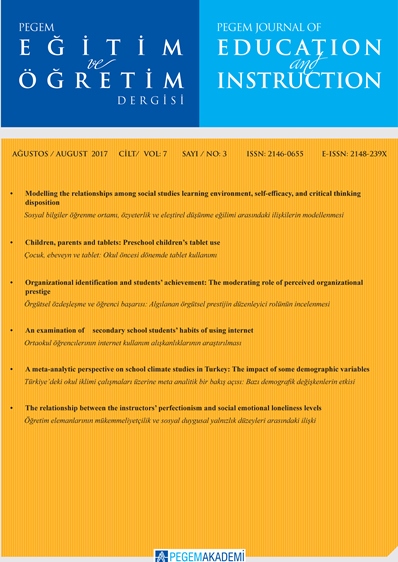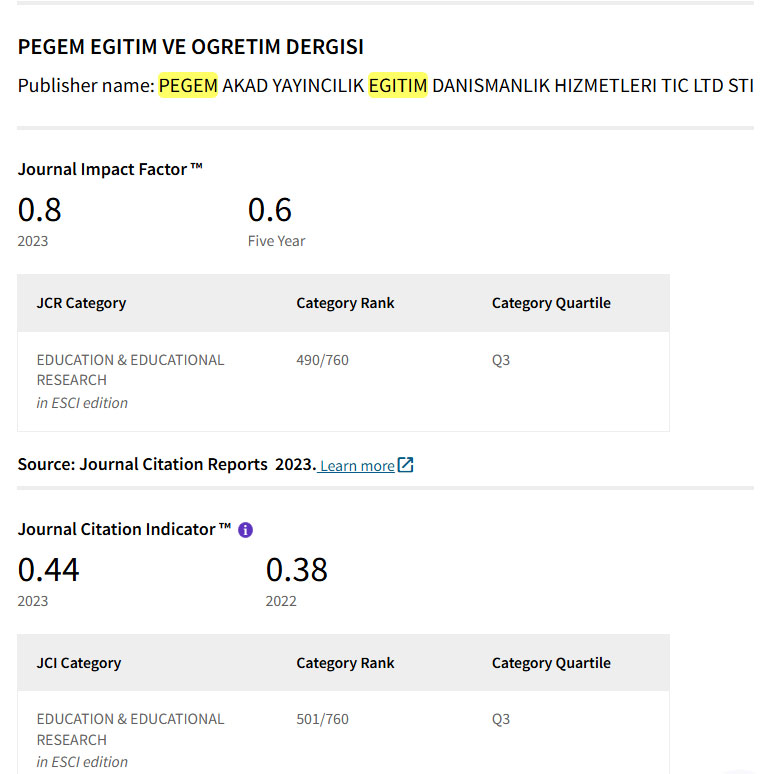Evaluation of a financial literacy program developed for high school students
Keywords:
program development, high school,, financial literacy,, Finance, literacyAbstract
The purpose of the study was to develop an education program at high school level for financial literacy skills mentioned within the framework of general competences and to test the effectiveness of the program developed. Mixed method where quantitative and qualitative research methods were used together in order to obtain data diversity was employed in the research. In the quantitative part of the study, experimental method was used, while in the qualitative part, case study method was benefited from. Within the scope of experimental design with the pretest-posttest control, in the quantitative dimension of the study, "Financial Literacy Behavior and Attitude Scale" was used. In the qualitative dimension of the research, the opinions of 12 voluntary students in the experimental group about the training were determined through an interview form. The results revealed that the financial literacy program developed for high school students positively affected their financial attitudes and behaviors. The significant difference determined between the students in the experimental group and control group indicates that the gains aimed by the literacy training program were achieved. In addition, the results obtained from the qualitative part of the research shows that the students' perception of money changed, that the program positively contributed to their lives, and that they wanted to receive the training in their early ages. Based on the results of the study, it is recommended for policy makers to involve financial literacy education in schools in a more systematic way.
Downloads
References
Adalar, H. (2019). Sosyal Bilgiler Öğretmen Eğitiminde Finansal Okuryazarlık ve Öğretimi: Bir Model Önerisi. (Doktora Tezi), Gazi Gazi Üniversitesi, Ankara.
Atkinson, A. & Messy, F. (2012) Measuring Financial Literacy: Results of the OECD/International Network on Financial Education (INFE) Pilot Study. OECD Working Papers on Finance, Insurance and Private Pensions, No. 15, OECD Publishing.
Büyüköztürk, Ş., Çakmak, E. K., Akgün, Ö. E., Karadeniz, Ş. & Demirel, F. (2008). Bilimsel Araştırma Yöntemleri. Ankara: Pegem Yayıncılık.
Creswell, J.W. (2006). Understanding Mixed Methods Research, (Bölüm 1). Erişim Adresi: http://www.sagepub.com/upm-data/10981_Chapter_1.pdf.
Danes, S. M., Huddleston-Casas, C., & Boyce, L. (1999). Financial planning curriculum for teens: Impact evaluation. Journal of Financial Counseling and Planning, 10(1), 26. 10(1), 25-37.
Ersoy, A. F. (2007). Sosyal Bilgiler Dersinde Öğretmenlerin Etkili Vatandaşlık Eğitimi Uygulamalarına İlişkin Görüşleri (Doktora tezi). Anadolu Üniversitesi, Eskişehir.
Gökmen, K. (2012). Finansal Okuryazarlık. İstanbul: Hiperlink.
Hawthorne, S., Rodgers, Y., & Wheeler, R. C. (2003). Economic Literacy Among Primary-Grade Students. Available at SSRN 433980.
Hogarth, J. M. (2002). Financial literary and family & consumer scences. Journal of Family and Consumer Sciences, 94(1), 14.
Hoşgörür, V. & Gezgin. G., (2005). Ekonomik ve Sosyal Kalkınmada Eğitim. Van Yüzüncü Yıl Üniversitesi Eğitim Fakültesi Dergisi.2(1).
Johnson, C.A. & Lewis, A.R. (2009). Consumer economics and family resources: importance of financial literacy. Journal of Family Consumer Sciences Education, 27(National Teacher Standards 4), 1-12.
Karasar, N. (2008). Bilimsel Araştırma Yöntemi, Ankara: Nobel Yayınları.
Lee, N. (2012). What is financial literacy, and does financial literacy education achieve its objectives? Evidence from banks, government agencies and financial literacy educators in England. In the Proceedings of 2012 Academy of Financial Services Annual Conference at San Antonio, USA E (Vol. 4).
Mason, C. L. J., & Wilson, R. M. S. (2000). Conceptualising fi-financial literacy. Occasional paper, 7. Erişim Adresi: https://core.ac.uk/download/pdf/2738276.pdf.
OECD. (2013). PISA 2012 Assessment and Analytical Framework
OECD (2014). PISA 2012 Results. Students And Money: Financial Literacy Skills For The 21st Century (Volume VI), PISA, OECD Publishing.
OECD. (2016). Financial Education in Europe Trends And Recent Developments Financial. OECD Publishing.
PISA (2012). Assessment and Analytical Framework Mathematics, Reading, Science, Problem Solving and Financial Literacy. http://dx.doi.org/10.1787/9789264190511 Adresinden 20.12.2020 tarihinde erişilmiştir.
Sarıgül, H. (2015). Finansal Okuryazarlık Tutum ve Davraniş Ölçeği: Geliştirme, Geçerlik ve Güvenirlik. Yönetim ve Ekonomi Araştırmaları Dergisi, 13(1), 200-218.
Subaşı, M. & Okumuş, K. (2017). Bir araştırma yöntemi olarak durum çalışması. Atatürk Üniversitesi Sosyal Bilimler Enstitüsü Dergisi, 21(2), 419-426.
Temizel, F., & Özgüler, İ. (2015). Finansal Eğitime Bakış. Business Management Studies: An International Journal, 1(3), 1-16.
Türkiye Cumhuriyeti Merkez Bankası (TCMB). (2015). Bülten. Sayı 37.
Varcoe, K., Martin, A., Devitto, Z., & Go, C. (2005). Using a Financial Education Curriculum for Teens. Journal of Financial Counseling and Plannig, Vol 47- (1). P.1-10.
Downloads
Published
How to Cite
Issue
Section
License
Copyright (c) 2021 Pegem Journal of Education and Instruction

This work is licensed under a Creative Commons Attribution-NonCommercial 4.0 International License.
Attribution — You must give appropriate credit, provide a link to the license, and indicate if changes were made. You may do so in any reasonable manner, but not in any way that suggests the licensor endorses you or your use.
NonCommercial — You may not use the material for commercial purposes.
No additional restrictions — You may not apply legal terms or technological measures that legally restrict others from doing anything the license permits.




